Expedition to Georgia 2013
All travel reports are translated electronically although minor improvements are sometimes made.
Expedition to Georgia 2013
Tour of the expedition: Kutaisi (Bagrati, Gelati, Mostameta, Prometheus cave), Mestia (Lake Kuruldi, Chalati glacier), Kobuleti, Batumi, Gonio fortress, great transport adventure from Kobuleti to Akaltsikhe (Vardzia, Sapar monastery), Tbilisi, Mtskheta, Gori, Uplistsikhe , Ananuri, Davit Gareja, Tbilisi, Rustavi, Gardabani, Kazbegi, Sinhnaghi , Tsari, Lagodekhi (border with Azerbaijan).
Marneuli (on the way from Azerbaijan to Armenia).
The border with Georgia
The border at Kutaisi Airport went very quickly and smoothly.
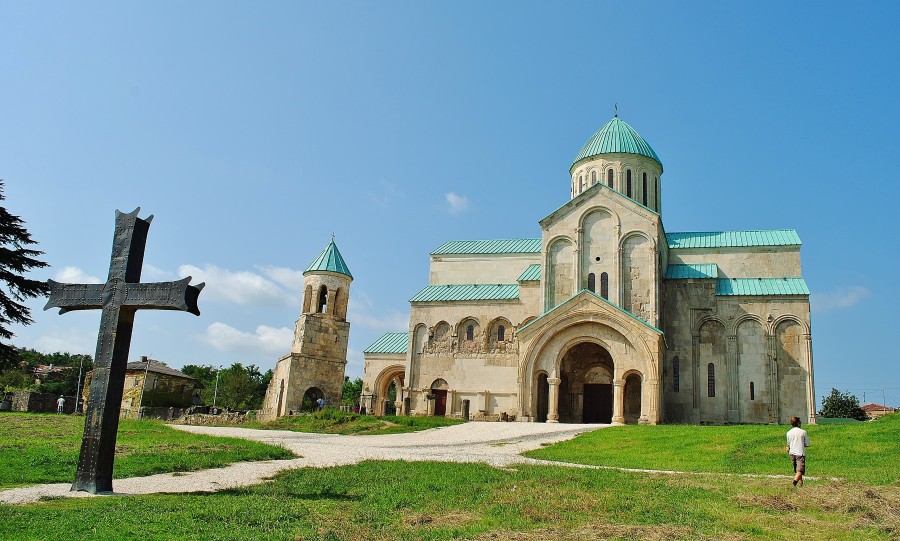
Bagrati Cathedral. Kutaisi, Georgia.
Transportation from the airport to the center of Kutaisi
Busi for 5 lari to the center although the driver tried to stretch the tourists for more.
Kutaisi
Kutaisi is the second largest city in Georgia and for many visitors it is often the first contact with this country due to low cost airlines. However, when compared to the capital of Tbilisi, Kutaisi is a very small, attractive city, offering a fascinating history and picturesque views of the Bagrati Cathedral. As a city of first contact, I think Kutaisi is a perfect place to meet Georgian culture, with nice people, good hinkali stuffs, cheese and a few monasteries. For hikers, Kutaisi is only a base for nearby monastries, such as Gelati, although I assure you that the rush in the Kutaisi case is extremely detrimental. In addition, Kutaisi is the second largest city in Georgia, which has been recorded in history as the capital of various kingdoms.
When I left the bus, I thought I was going to have a lonely trip, but this time it was different. Immediately after I looked away from the beautiful girl walking through the city center, I noticed that Kamil was on the curb, my travel companion with whom I had traveled most of Georgia. From the main square of Davit Aghmasheneblis moedani we went up the road to the nearest and unmolested, also the cheapest hostel in the city. At the house covered with grapes we stayed in a dorm room for only 15 lari per night.
The springs seemed to be heavily worn out because I fell half a meter but it did not matter at that time.The flight from Warsaw was tiring because I had to get up at 4am. After the housekeeper’s nap, she gave us watermelon and the grapes we had in abundance as they grew over us. It was clear that the street where I lived was not a resort, but an old and tired row of houses with people putting down the gas bill.
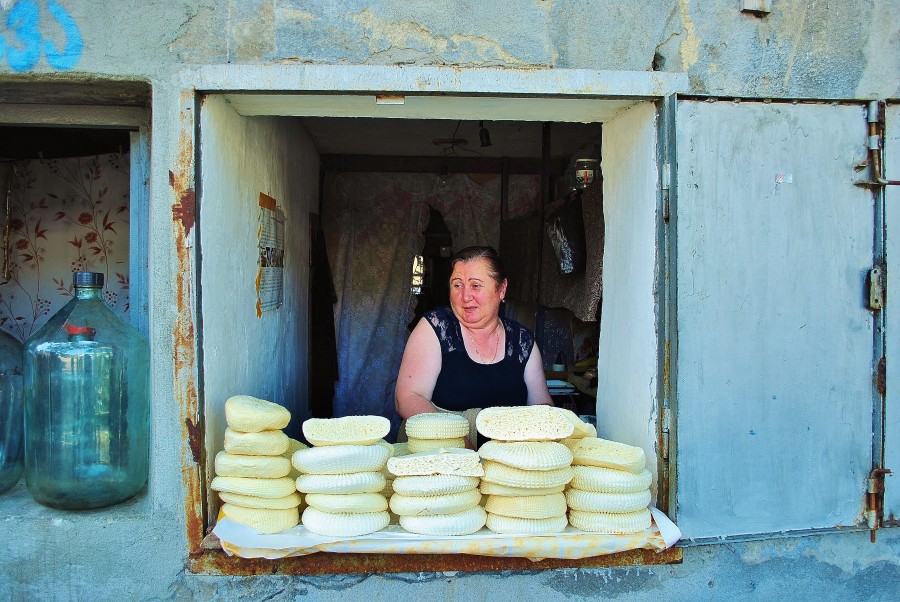
Georgia produces very good cheeses and many kinds of bread. Food in Georgia is very good, so traveling around Georgia is also a culinary adventure.
I assure you, however, that over the years, after having gone through the darkest holes in Asia this time, I felt so luxuriously surrounded. Unfortunately, there was a heat that was very tired, but despite that, very quickly and with even funny faces we went to the square Davit Aghmasheneblis . In the center was a large fountain with figures of horses and various figures. Against this was the theater and the central park where I once had fun. The green area in the heat of Georgia with the possibility of drinking tea and eating the haczapuri cake (very fond of ladies) definitely relaxes. Shortly after, we went to the theater where we tempted to taste local cheeses and rolls and on the margin Kutaisi is famous in Georgia for its delicious pastries. On the occasion we tried again hinkali and talked with people and to our delight immediately it was clear that Georgian people like Poles. Then we passed the fruit and vegetable bazaar and stood on the bridge over the river Rioni. From here I could admire the elemental, wooden huts on the cliff like those of Nepal and in the distance the mountain peak and the cathedral of Bagrati.
First, however, walking along the winding streets and stone houses covered with vines we reached the Haber monastery . It was a typical Georgian stone church with one bell, nice arches and a comprehensive interior and paintings. Then we sat down in town to again try the wonderful buns with white cheese and then climbed about 20 minutes to the top of the mountain to stand before the door of the eleventh century Bagrati monastery . This building is a real art of Georgian religious architecture and is visible from every part of Kutaisi as a symbol of the city. In 2012 the church was renovated after hundreds of years of destruction. Bagrati is in a white color, has many beautiful arches and pillars and a green roof and in front of it is also a magnificent cross. Bagrati is also a heritage of Unesco’s world culture and is one of the region’s major attractions.
Then we went to the Mtsvane Kvavila district (Green Flower), which is very interesting because of the old buildings, often destroyed and often also showing the standard of living in Kutaisi. A series of shabby homes and rusty gates with men repaired cars and people in the windows. However, it is a very atmospheric and open-minded place to live in Georgia, and at the top of the mountain there is also a monastery with three churches, a cemetery and a view of the river and the dam. Kvavila Mstvane was once inhabited by thousands of Jewish families who returned to Israel. There are also two synagogues below but the gates were closed. On the way to the top I also met a pretty girl with whom I have contact so far. After a little shopping I returned to the hostel because it was a very hard day because of the early morning. The first day in Georgia made me very impressed and Kutaisi was a good introduction to a new country for me. In addition, Georgia is a country rich in fruits that grow in every garden and women are nice and smiling.
Another time, between trips I also went to the Kutaisi Historical Museum , then once again to the central park for tea and again to the cheese buns. This museum was worth my time as it included medieval weapons, costumes, instruments, jewelery, Christian art and archaeological finds.
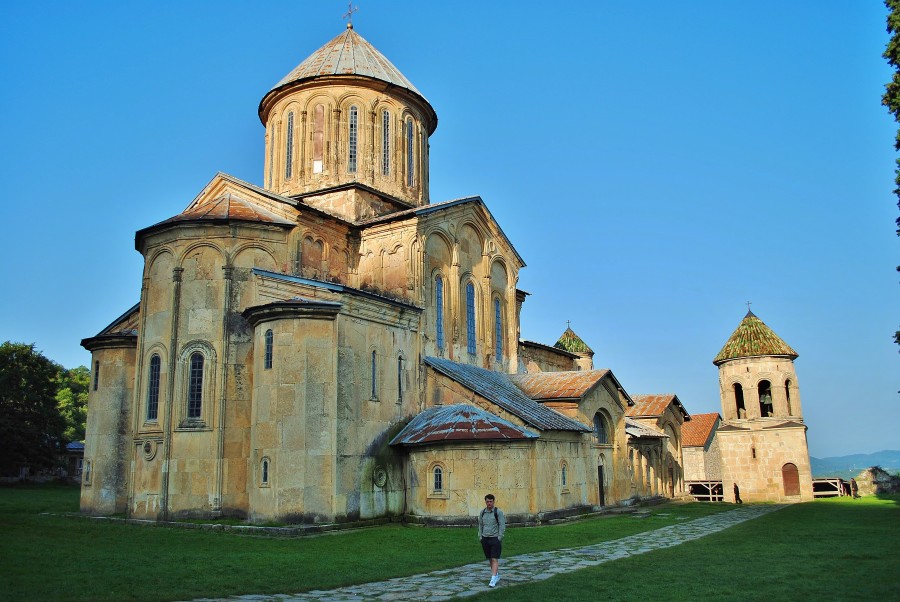
Gelati Church. Kutaisi, Georgia.
Trip to Gelati and Matsometa monasteries
Gelati and Matsometa monastyrs are the most popular of the Kutaisi and in my opinion definitely worth a visit. From the bazaar in Kutaisi I took a small bus for 1 lari and within 15 minutes I was already near Gelati.The Gelati Monastera, located in the picturesque mountainous terrain, was built in the early 12th century and has served not only as a church, but also as a burial place for rulers. The Gelati monastery was burned in the 16th century by the Ottomans and in the 20th century the communists removed priests and closed the facility. Today, however, Gelati lives a full life, also because of its attractiveness for tourists. A lonely monastery built of boulders about 900 years ago consists of a main cathedral with a traditional Georgian bell, a church and an impressive southern gate. Gelati was created over many centuries, so in the 12th and 18th centuries frescoes and mosaics of Mary and the Child were created. There are also wells and a few shady places that are well protected against the Georgian heat. Outside, there are souvenir stalls and walking animals.
Then I and my colleague went down the winding road passing houses and fruit orchards. Along the way there were grenades that were very common in Georgia and also near the grapes that gave the shade to the hosts. My walk lasts about an hour therefore the Gelati to turn on the Motsameta are 4km and advise not to take the bus to not lose the charms of nature. From the turn to Motsameta are the next 2km which we first went through and then we managed to catch the hitch.
Motsometa monastery is another trip in time to the architectural splendor of Georgia, which is additionally located among the beautiful open air. It is not clear when exactly the Motsometa monastery was built but it is much smaller than the Gelati and I also noticed that especially here you need a very good lens as it is difficult to photograph the whole object on a very small square. Motsometa is more delicate, built of smaller stones, covered with red tiles and has a nice tower with a cross at the top. The monastery leads to a stone passage and then another. It is a very quiet, peaceful place with nice views.
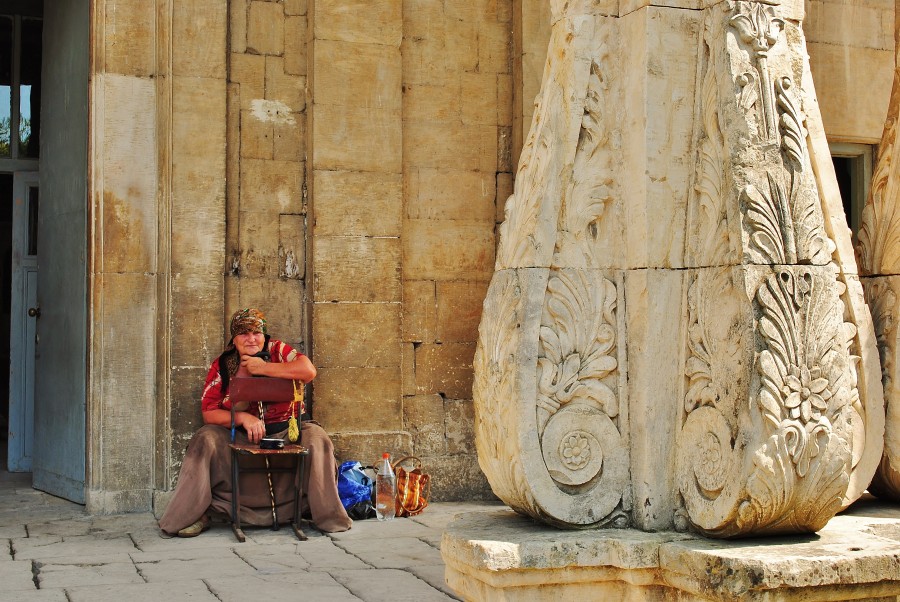
Details on one of the churches. The churches in Georgia are a work of art, and the reason why you should go there.
We came back with two hitchhikers. The distance from Kutaisi to Motsometa is 6km and then another 4km to Gelati.
Prometheus Cave
Prometheus cave is next to the cave of Sataplia the most beautiful cave in Georgia. Tourists come every 20 minutes with an English speaking guide and the entrance costs 6 lari. When I came from the hot climate of Georgia to a damp and cold cave, I immediately felt relieved. The entrance is also beautiful because first I had to go down through the forest to get to the tunnel covered with vegetation. In the middle, there is a 1060 meter illuminated multi-color trail. Prometheus cave is a show of stalactites, stalagmites, fossils of waterfalls, underground rivers and small lakes. Every little detail of this cave, the condensed water pearls and even the echo made me feel even though I had seen some of the best caves in Asia. I was among the biggest caves in the world in Borneo and in the very impressive in Laos but still cave Prometheus in Georgia is worth a ride there because it shows tourists very well that nature can create beautiful art. Being here I became interested in the beauty of the Georgians, who at my request posed for photos.
At the entrance to the cave there is also a shop where the host offered us watermelon and homemade honey and my colleague also made a Georgian whiskey of his own product. The weeks for Kamil turned out to be a gourmet holiday.
Transportation to the cave is not complicated. First, from the area of the Red Bridge in Kutaisi, you took a 10km bus ride to Tskhatubo, which is a tragic reminder of communism. There is a park with a dry fountain, asbestos-plate houses, a bus station that remembered Lenin and a really bad road. With Tskhatubo you should take a taxi to the cave but we took a hike leading through winding roads with fruit trees. On the way back, of course, only hitchhiking.
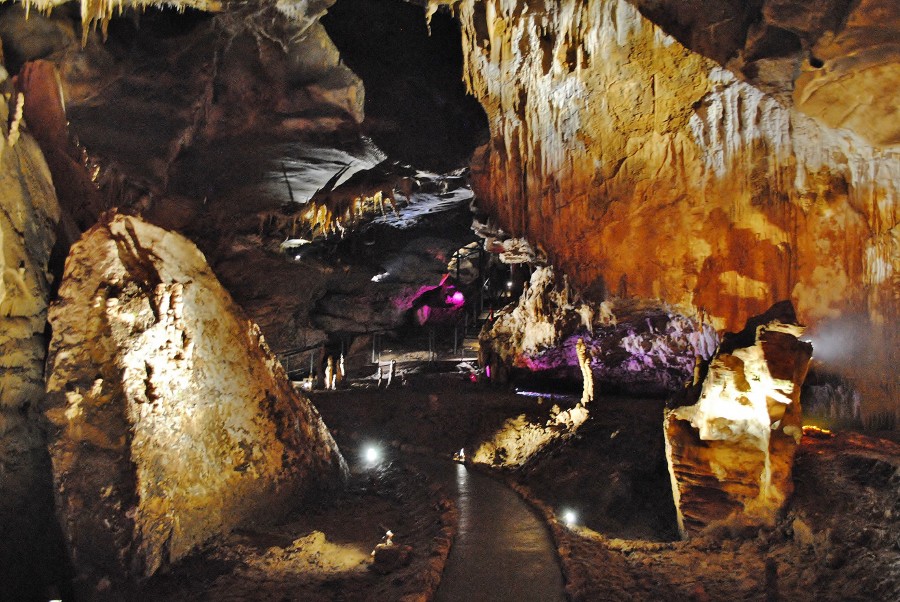
Prometheus Cave. Georgia.
Transport from Kutaisi to Mestia
From the center of Kutaisi we took the city bus to the station near McDonald’s (about 3km), and from there we just got on the bus going to Mestia, although our trip took 2 stages. First we went about 2 hours to the unfriendly, poor town of Zugdidi near Abkhazia, and then we went about another 2h to Mestia.
The first part of the trip was uninteresting because we were on a flat road like a pancake and if the bust of a woman near me who obviously caught my eye would probably fall asleep.
The second part of the trip was already more interesting, but unfortunately no breast. We drove through the mountain streamers, rich vegetation and turquoise lake below. On this journey I remembered that two couples were riding around, one from Germany and the other from Israel. It was funny that the Jews treated the Germans with great distances and did not seek contact, while the Germans were willing to prove their friendship to them. What a spoiled nation.
Unfortunately, it was also the most expensive trip in my entire career in this country. I was poorer by 25 lari.
Mestia
Mestia is the main town and tourist base in the northwest of Svanetia. Mestia lies at an altitude of 1500 m and is known for its defensive towers built in the early 13th century as fortifications against Mongol invasions. Some believe alone and others are connected to homes.
Besides, Mestia is a beautiful town famous for its mountaineering and scenic mountain hikes. Some of them are trips to the Cross and Lake Kuruldi towards Ushby, expeditions to the Chalati Glacier and to the picturesque town of Ushguli.
As soon as we arrived we immediately got a room for 15 lari which is cheaper than usual. The beds were falling, but after the expeditions to the mountains and the cold nights in the tent, it did not really matter. In the house where I lived, the tower was connected to the house and I also had the opportunity to look at the area also from a myriad point of view. On the first day we went with a colleague to look around the town and take pictures of narrow streets, old Soviet trucks and towers against the mountains. We were also in the local pub on the Hinkali dumplings, which I then had many times but in Mestia were the best. In the evening there was a party and the Georgians chased Georgian vodka called “chewing” which they did themselves. They also had their own wine and a whole selection of fattening chaczapuri breads. We talked about life in Poland and in Georgia and it was nice to have time though I obviously did not drink. Kamil was in the seventh heaven. They drank and they ate until 2am and then did not sober for the whole weekend.All the time, however, it was very nice. In Poland we would have been beaten several times and in Georgia nothing had happened.
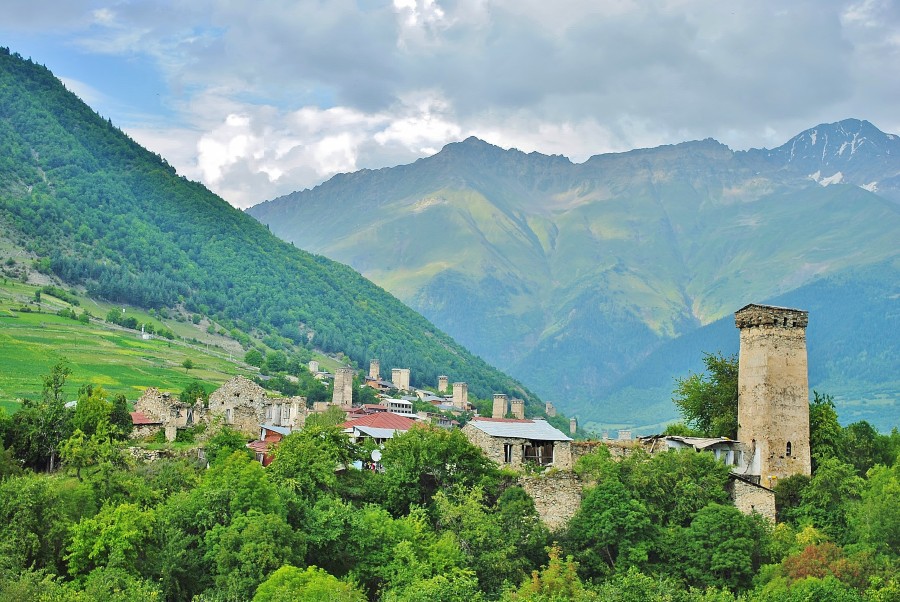
The village of Mestia and the picturesque Georgian mountain landscape.
Hike towards Chalati Glacier
One of the most popular attractions near Mestia is the expedition to the Chalati Glacier. From the center of Mestia, a walk at a slow pace with breaks for a meal in the bosom of nature and for photos takes about 3.5 hours one way. The beginning is weak because we had to go along the asphalt road, near the airport and we passed Soviet trucks that smelled the air. After about 2 hours, a pleasant trail of compacted earth began, surrounded by vegetation, interesting rock formations and a rushing river nearby. After another 30 minutes, I reached the vertical rock on the right side where the climbing competition was taking place, and a moment further there was a suspension bridge giving the opportunity to observe a beautiful panorama and a loud, rushing river. It is only an hour from the bridge to the foot of the glacier and I classify this place as a new stage of the trip and a great place for photos at the same time. Then we entered the dirt road which was much nicer. We walked through the forest, walking along a narrow trail, on both sides with stones covered with moss and the climate of the Caucasian forest.
One time I went down the hill and other times I had to climb and often I had to avoid boulders on the road and flooded parts of the trail. Anyway, it was fun and an adventure for which I came to Georgia. After crossing the coniferous forest, we entered the last stage of the expedition, i.e. a plateau with scattered boulders, a river on the left and a naked glacier in front of us. This stage of the trip was by far the most lonely and here I felt the most uninterrupted contact with nature, just like before in the mountains of Tajikistan or on the Mongolian steppes. However, this area was much smaller and therefore I also recommend it to unprepared travelers. Walking along the trail, we soon reached the foot of the glacier from under which the river was flowing. This is where the marked trail ends and here begins the stage from which people with equipment can start a more advanced climb.
Then, from the foot of the glacier, we returned about 20 minutes to the campsite by the river and here we put up tents and lit a fire. The evening was pleasant. I was collecting brushwood, we lit a fire and I collected some wild strawberries. Luckily for us, there was also a Georgian family that was returning to Mestia and gave us some food. In addition, I also took water from the river to boil for tea and in the calm of nature it was going to be a nice night. However, it was completely different because soon it started to rain, it got cold and very unpleasant. In the morning, wet and cold, we returned the same road to Mestia and despite the good adventure and nice views, it was the first time we did not want to smile.
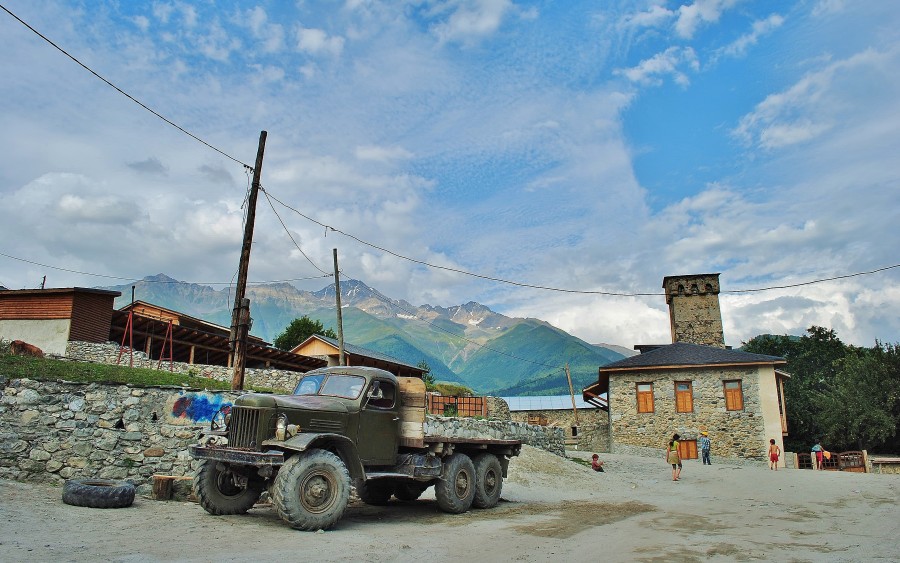
Mestia – a picturesque mountain station in Georgia.
Even though my trip was beautiful, after returning to Mestia, that day I was just sleeping and drying my clothes. The rain, exhausting march and a number of other activities made me exhausted.
Climbing to the Cross and Kuruldi Lakes
leads through a stone road and then comes in close contact with nature in the form of forested trails, open logs and walking cows. On the way there is also the possibility of taking water from one of several small springs and the higher the view is, the more beautiful. Climbing to the Cross took us 2h. From the cross in good weather you can also see the summits of Mt Ushba (4710m asl) which is the most demanding mountain resort of Mestia. The cross is basically the first stage of any climb, it is a place of rest, meeting people, beautiful views of vast clearings and Mestia down. For example, we met two Poles with whom we later talked in the evening in the park and had short dances.
From the cross myself and my companion decided to climb up to 300m higher, that is to Kuruldi lakes.Unfortunately 300m was less than 3h climbing and despite the beautiful views, the time and effort invested in 300m turned out to be larger than the first stage of 900m. On the way we saw a herd of cows colored like tigers and nice yellow flowers against the snowy summits of Ushby. Same lakes were very small and inexpensive and my travel companion instead of taking pictures of nature made pictures of the butt lying down, which climbed not far.
10h expedition in the mountains made us finished but of course worth for the beautiful views.
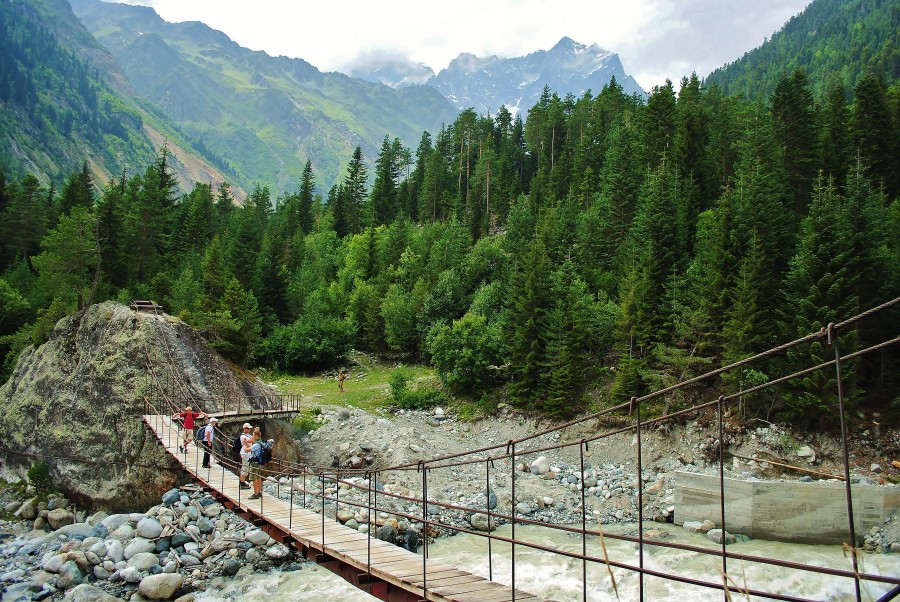
Mestia offers many mountain walks. The main one is climbing to the Cross and the Kuruldi Lakes.
Transport from Mestia to Kobuleti
My next adventure was full of stops and stops. From Mestia to Zugdidi I took a trip through nice mountain views and on the way we had to wait because the avalanche slipped the rocks to the road. This part of the trip lasted 3 hours and cost 20 lari. Then from Zugdidi to Poti it costs 6 lari and 1h time. From Poti to Kobuleti I went 45 minutes and paid 5 lari.
As we can see, mountain transport in Georgia is much more expensive.
Kobuleti
Kobuleti this small town on the Black Sea, which I recommend to those who do not want to hear loud Batumi. Kobuleti is much smaller, quieter and you can get better rest. When we got off the bus we did not want to bargain because we went with the driver to the hotel by the sea where the bed and shower room paid only 15 lari. Next to it was a center, fruit stalls and a promenade for tourists. In Kobuleti I spent 3 days swimming in the cold Black Sea and relaxing. It was also my base for a few other places I will discuss below. It is also worth mentioning that the beach in Kobuleti is rocky and the waves are high and strong.Treba to be careful.
Batumi Botanical Garden
Batumi Botanical Garden is located on 111 hectares and is located in Cape Verde on the Black Sea. It is a very rich, beautiful and extremely diverse park which is also the largest of all the former Soviet Union. This garden is divided into many geographical sections, which means that there are lots of vegetation here from South America, Australia, New Zealand, East Asia, Mexico, the Mediterranean area and the Caucasus. This makes each part of the park completely different because the vegetation moves us to other continents.Batumi’s garden beats with its color and diversity, skillfully refined parts of light and shade, and ponds and roots of trees emerging from the forest trail. Also impressive is the place where you can see the flat rocky walls and down the Black Sea. I spent 2.5 hours here and I was not bored. I would definitely recommend.
The botanical garden is 20 minutes drive from the Kobuleti and you have to get off on the way to Batumi and go to the park. For the ticket I paid 6 lari and transported 1.5 lari.

Batumi Botanical Garden. Georgia.
Transportation from Batumi Botanical Garden
To travelers traveling to Batumi I advise you to wait for the next bus. From the Garden to Batumi is only 9km from which part runs along the sea. For transport I paid 1 lari.
Batumi
Batumi is a popular tourist city of Georgia and an important port on the Black Sea and the capital of the autonomous region called Adjaria. Batumi lies in subtropical climates and although the branches of the economy are citrus fruits, shipbuilding or food processing, the city’s chief focus is on tourism. Batumi is close to Turkey and attracts many tourists from there as well as from former countries of the former Radziski Union. In addition, with a population of almost 200,000 and a long beach and very well-developed tourism, Batumi is not tiring compared to other major cities. Since the breakup of the Soviet Union, the panorama of Batumi has changed a lot. There were many good hotels and restaurants and modern buildings by the sea, the old town was rebuilt and a promenade by the sea was built. Batumi is decorated with tropical plants and interesting sculptures and art. Here you have to walk along the beach after 1.5km of Batumis Bulvari promenade, but I warn that the beach is rocky and the waves are very strong. At the end of the square is the Ferris Wheel, 145m Alphabet Tower and Radisson Hotel.
My favorite squares are the Theater Square, with richly decorated fountain sculptures and Neptune Square, the fountain in front of Batumi University and the Cathedral of the Mother of God. Not to be overlooked is the high Sheraton Hotel towering over the city near the sea and built on the lighthouse pattern in Alexandria. Also worth mentioning is European Square and high pillar sculpture, which in my opinion is too high to see it and reportedly cost more than 1ml lari. Wasted money. For dinner richer tourists I would recommend Piazza Square although I myself was on a shed for a few lari and it was well. In addition to this, Batumi has several museums and theaters although the best showcase of the city is the beach itself, the Old Town, the tropical climate and beautiful spots and some strange buildings. Batumi is indeed a very pleasant place.
The only thing that bothered me here was the presence of gypsies who would catch people even when eating and settling down in the small streets. Wherever I travel, I am convinced that Adolf Hitler was definitely right in relation to the Gypsies.
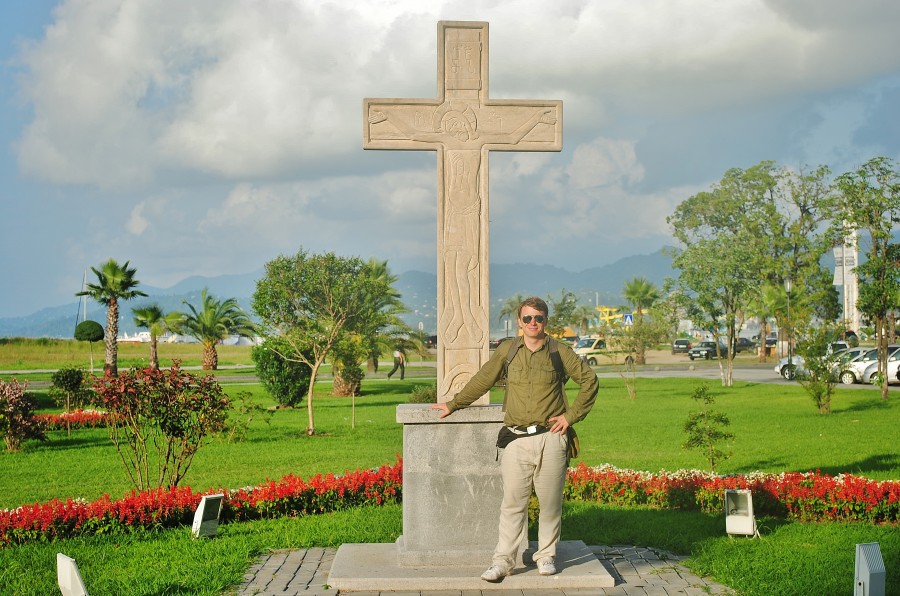
Christianity is very important in Georgia. They include beautiful art and architecture.
Gonio Fortress
11km from Batumi towards the border with Turkey there is a very well preserved Roman fortress with a beautiful garden in the middle. This fortress has 18 towers and a defensive wall to walk around, as well as a Roman bath and theater. The entrance costs 2 lari and right after the entrance I advise you look up for kiwi fruit. Continue the trail through high red flowers and another green. This fortress, in my view, is worth visiting for its history, but on the other hand without rich vegetation would not be the same. Here you can see how much can make a beautiful garden.
On the other side of the street there are bars with drinks and ice cream, which are necessary for the Georgian sun. Transportation from Batumi takes 20 minutes and costs 1 lari.
From the fortress of Gonio to Sarpi where the Turkish border is only 6km.
Transportation from Kobuleti to Khulo
From Kobuleti to Batumi – 0.5h / 1.5 lari. Then from Batumi to Khulo 2h / 5 lari. The route led through scenic mountain views and down below was a valley cut across the river and green hills.
Khulo
Khulo is a small, unattractive town with a very nice church and small market. Khulo consists of the lower part which serves as a base of interchanging and the upper part where the locals live in their blocks of plates bore to death. I decided to put Khulo on the map only as a transfer base.

Gonio Fortress. Georgia.
Great adventure in transport from Khulo to Akhaltsikhe
(Night in a wooden hut and women’s training)
In this part of the reportage, I intend to tell about my journey through the gates of Georgia, which Georgians themselves have not heard, and about my night at the Hasan host who turned out to be one of the more memorable and entertaining.
After seeing Khulo, a small mountain town famous for boredom, I wanted to go on a journey as soon as possible. I could stay overnight in Khulo because it was a room but the desire for adventure was stronger.Me and my brave travel companion sat down behind the town on a dusty and rocky road at the edge of the abyss and waited for a hitch that turned out to be reasonably comfortable. First we went to the small village of Purdzai, which probably is not even on the map. Then you stopped at the 30-year-old Nice Niva and took us for at least an hour to Godezi, which is the highest point of the route. On our way our Lada broke several times and therefore every now and then we had to stop for the engine to rest and to add cold water. Besides, the road was only a pile of rocks and dust, so we were rocking all the time.
Then, from the top of the mountain, we drove a few kilometers down to the village of Lodidziri, who probably had not heard much. Here we had to spend the night in the tents but he took us to the local host for 15 lari a night with great dinner and breakfast. We spent the night in a wooden cabin surrounded by a field of potatoes and mountains. The host was unshaven from a dark star named Hasan, who had two slave servants at his disposal – his wife and daughter. I have to admit that Muslims, however, know how to introduce absolute discipline into the house because both at the Islamist’s command seemed to be blowing up to serve men.Besides, I have never heard a word please. It was just a hoarse roar. As it turned out, the women got up early and went to bed late because they had to handle all the housework and do all the housework. In addition to Hasan and me and his colleague Kamil, there was also a colleague of Hasan who came to tell us unreleased stories. The table was filled with Georgian dishes, haczapuri, many kinds of sour cheese, and of course his own homemade alcohol. I do not drink alcohol but Kamil as usual rescued the honor of Poland and settled with them. But the women did not sit with us at the table and when I asked if they were hungry, Hasan said they had eaten and that it was our turn now. Women were at every command. Of course we talked about money, about business, about how much money in Poland and how much it seems. The next morning when I got up the men were sitting at the table, they ate relaxed and of course drank and the women worked in the field, with cows and with the service of their lords. Breakfast was delicious but talk of course only came down to money. They were curious as to how much my camera and phone costed us and they kept pushing us all the time as they liked us and not to be afraid of anything.Then we left and everything went well and they watched us from the terrace.
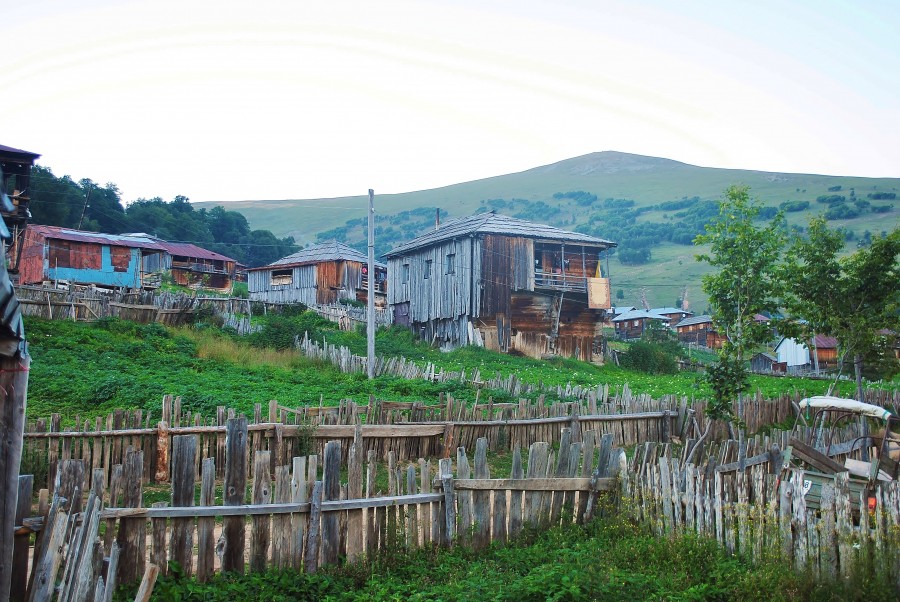
My luxuries hotel in the village of Lodidziri. Georgia.
We quickly caught a new hitch, but after 10 km of empty, rocky roads, the driver left us because he decided that he did not want to lead us any longer. After that, we waited, resigned and bored, for about 1 hour and finally a van with vegetables and watermelons took us and in terrible conditions we got to another village called Odigeni. From here there was a marshrutka straight to Akhaltsikhe. It was the last leg of the journey which cost 2 lari and took half an hour. The distance between Odigeni and Akhaltsikhe is 18 km. As you can see, sometimes transport can turn out to be a very interesting, even unforgettable stage of the journey.
Akhaltsikhe
We could not believe that we were finally able to reach Akhaltsikhe but luckily our long road ended with success. Akhaltsikhe is a small town so the hostel was also close by. We were able to find a room for only 15 lari from a person though they wanted 25. The fact that I am from Poland and speaking good in Russian always helps a lot in lowering the price. Akhaltsikhe is a town where life flows very slowly. There is a bus station with many unemployed tasers, a watermelon stall, a pretty church and a few pubs. But what attracts tourists to this small town is the beautiful castle of Rabati from the 12th century and some beautiful objects outside the city, such as the rock town of Vardzia and the monastery Sapar.
Rabati on the top of the mountain and the dominant view over the Akhaltsikhe is a restored castle of the 12th century with defensive walls, museums, churches, synagogues and mosque. Rabati is a huge, well-groomed object that can be moved into the medieval times of Georgia. I walked here on defensive walls, entered the towers and saw the exposition of old Caucasian carpets and 16th century manuscripts. The presence of the Old Town and the views of the city peak were the most interesting. Rabati also consists of several squares and many levels, most of which are planted. In addition, there are interesting basement passages decorated with arches overlooking the golden dome and gazebo on elaborate pillars. Rabati is not only a medieval castle but also a showcase of art and history in a very attractive form.
I think one day is enough to see Akhaltsikhe, its bazaars, the church and definitely Rabati. At the end of the day, I would recommend organizing the next day.
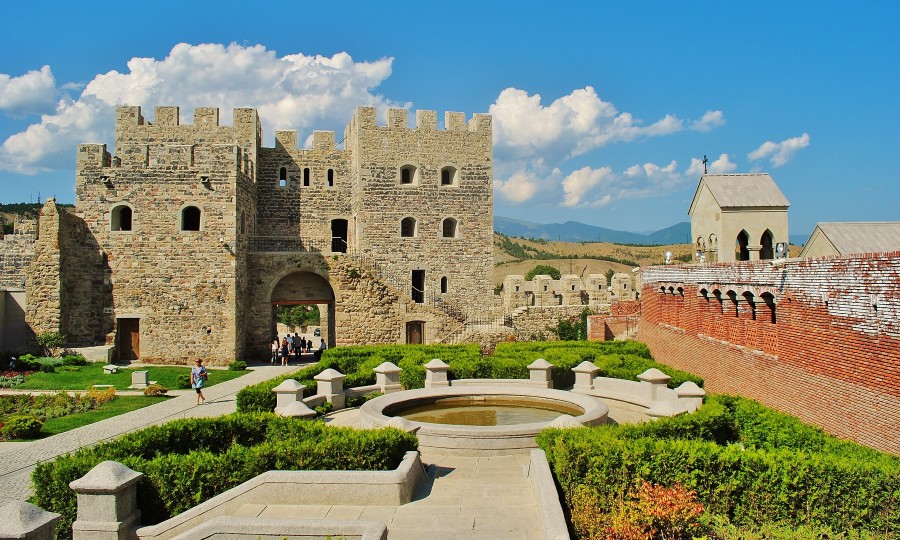
Rabati Fortress. Akhaltsikhe. Georgia.
Trip to Vardzia by the Khertvisi fortress
Together with a colleague we made a price with a taxi driver of 40 lari for almost a whole day of riding which was a achievement since we had heard such amounts as 60, 80 and even 100 lari. However, since I spoke Russian the price immediately fell. Our goal was to drive to the rocky town of Vardzia on the way stopping at interesting objects. Our route led through the beautiful, picturesque valley of the Caucasus, along the way passing the canyons and moving along the mountain serpentynach. On the one hand I saw a river and mountains burned by the sun and alternately mountains and fields. Our first stop was the town of Rustavi where we made small shopping and where outside of the supply it is not worth spending a moment. But maybe it’s too hasty to say because when a young woman with a bust of D was approaching the store, they all fell silent with admiration, staring at exactly two things, which meant that there were times in Rustavi .
Then we stood on the road to admire the views and the monument to the poet Rustaveli. Then we passed through the village of Aspinadza, which is not worth commenting so soon afterwards to stop at a magnificent property – by the fortress of Khertvisi . It was a ruined castle built between X and XIV century, which beautifully dominated the mountain landscape. The road to the summit led along the rocks in the company of goats and asses, which means that the element of adventure is guaranteed. You can get through the gaps in the walls and there is nothing in the castle itself. A great attraction is climbing to the top and a view of the castle itself from below. However, it is best to go to the other side of the road where there is a hanging bridge on the river and also a dream place for a photo. Fortceca Khertvisi is a compulsory stop on the way to Vardzia, where you can also add water from the local well.
Then, continuing on the Caucasus’s mountain streams, we headed for Vardia, although on the way the driver pointed us to a few other insignificant objects. One of them was a bazaar of slaves, or several walls near a road stacked with mountain stones. Another object was the ruins of the Tmogvi castle , which from the road did not look anything special but I am sure that a mountain trip to this very rich history would be very interesting. Tmogvi Castle was a very important fortification building from around the 9th or 10th centuries and there are still ruins of the church and the remains of the 13th century frescoes. Then we saw a small rocky town, Vanis Kvavebi, from the 8th century, and the walls of the 13th century. This property is often overlooked because it does not equal its size and attractiveness to the famous Vardia. After 16 km from Khertvisi fortress, we reached Vardia.

Georgia; Rabati Castle in the city of Akhaltsikhe.
The rocky town of Vardzia is the largest of its kind in Georgia and also closely related to the culture and history of the Georgians. Vardzia is a powerful structure carved into the rocks, with many caves, tunnels and chapels, and they believe in the bells that cost the oceans of hard work and which has been consistently one of the cultural symbols of Georgia since the 12th century. Because of its size, it has been created for centuries, and by the new generations of the royal family. Vardzia was started as a fortification by Giorgia III in the 12th century and continental as a place of Christian worship by his daughter, Queen Tamara. Looking at Vardia from a distance, this object is astonishing in its size because it is a rock wall that has been cut into a large city consisting of 13 floors.
To better understand the size of Vardzia it is worth adding that its two parts are divided by a church engraved in the rocks, of which there are 242 rooms in the eastern part and 165 in the east. These rooms include smaller and larger chapels, caves, bakeries, guest rooms, cemetery and infrastucture in the form of tunnels, corridors, ladders in the rocks, water facilities and places to defend. In addition, the largest church features impressive 12th-century frescoes depicting scenes from the New Testament and the life of Queen Tamara and her father. In addition, the church leads about 150m of tunnel leading to the rocks above the church.
It is important for me that my readers understand that Vardzia is not just a few holes in the mountains, but a whole city in the rocks adapted to life just like any other city of that time but built in rocks and having a strong cultural and religious identity. I think this is an object that should not be missed.
Then we drove towards Akhaltsikhe the same way, although I got off early to go to Sapara monastery.
Sapara monastery
Coming back from Vardzia, the driver dropped me off at a fork road from where to Sapary was still about 12km after a difficult rocky road. At first I grabbed a hitchhiking but only for a couple of miles and then came up a little and waited in the rain. I admit that I had a bad mood because the time of day and the weather was not very promising, and with all this Sapara monastery because of its distant location, lack of organized transport and even the lack of normal road is rarely visited. However, even in such a hopeless situation, my adventure saved the Germans. On that day a group of German professors from the University of Münster came to Sapary and they took me with me and then back to Rabat in Akhaltsikhe.
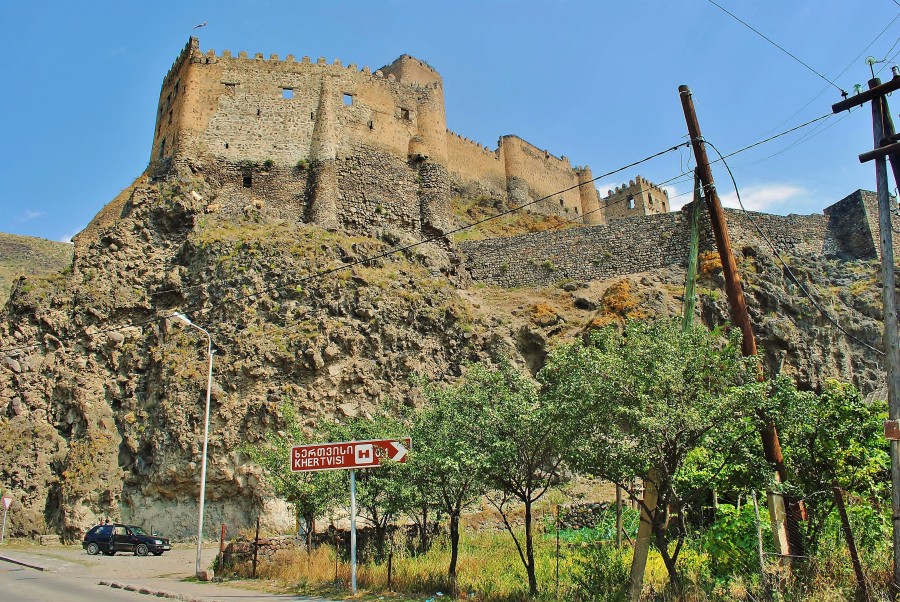
Khertvisi fortress which dominates the beautiful mountain landscape. Georgia is full of gorgeous castles, fortresses and old churches in the mountains.
Monastery Sapara is a church built around the 9th century surrounded by mountains and beautiful vegetation and strategically located on the cliff edge and away from civilization. The whole complex consists of three churches built of stones giving it a heavy, monumental, medieval style. It rains in the rain and with the sound of trees I think Sapara is perfect for horror scenes and maybe that is why I bought a cross that I wear today. The church of the Saba has well preserved 14th century frescoes, though for me the best place was the place. At last I climbed up to the top of the mountain above Sapara, but do not expect good views from here.
For those who are not so fortunate, I recommend taking a taxi from Akhaltsikhe for a maximum of 15 lari in both directions.
Transportation from Akhaltsikhe to Tbilisi
My trip lasted 3h and cost 12 lari. On the way I passed, among others, Borjomi and Gori. Borjomi is a famous spa town in Georgia, where healing water of the same name comes from and a very nice place to spend a couple of nights for couples. But I was alone because I did not stop. Gori is Stalin’s birthplace and his museum, and I came back after a few days.
Tbilisi – the capital of Georgia
Tbilisi is an ancient capital of Georgia almost uninterruptedly since the 5th century. Tbilisi is a political, cultural, social and economic center of the country and a place where, despite differences in regions, every Georgian is identified. Tblisi, situated on the Mtkvari River, boasts an ancient Old Town with many beautiful churches, streets filled with restaurants and art, as well as a popular hammam and fortress dominating the city. On the other hand, Tbilisi is also an architectural city in the 21st century, preserving its traditional Christian culture, and by its architecture also a link with the former Soviet Union. Examples include the newly built huge Tsminda Sameba Church and, on the other hand, modern hotels, presidential palace, shops and entertainment venues. According to generally accepted opinion Tbilisi is the most attractive of all Caucasus cities, although I think that Baku has made many beneficial changes over the last few years.On the other hand, the history of Tbilisi is short-lived, mentioning that it was under the rule of Persians, Arabs, Turks and, of course, Russia.

Metekhi Church on the cliff with the statue of King Vakhtang Gorgasali on horseback. Tbilisi, Georgia.
Apart from Tbilisi itself which was my base for many days I went out for many interesting trips outside the city.
I arrived in Tbilisi this afternoon and got off at Didube station where there are merry-goers outside of misto.Didube is an unspoilt, chaotic open air station where there is a fruit bazaar, a barrel of bread, a row of shops and a general chaos. This is a type of place that is very tiring and which I recommend to leave quickly. Fortunately, there is a metro station that saves the whole situation. For only 50 tetri after about 20 minutes of driving I got off at Marjanishvili station and then going uphill for 10 minutes I got to Chitaia 12 where in the hostel run by an older lady there are the cheapest beds in Tbilisi. I paid only 10 lari per night. The center of the Old Town and the entire historic area I met great because I have come here many times.
From Chitaia Street I took the route and got off just behind the Gorgasalis . Most tourists start visiting Tbilisi from this place but I like walking in non-tourist places. Walking down a bit further, I saw old buildings and an unbelievable roundabout, but also spectacular rocks with the Kura River on the right and a pretty church on the top of the mountain on the left. Shortly afterwards I reached Abanotubani, which is a district of the bath which is about 1500 years old. There is a planted square, several baths of which the Orbeliani is more infamous, and a few small mosques that survived the Beria rule. There is also a road leading to the Narikala Fortress and Botanic Gardens . Below is also a very nice road with a view of the small cliff cut into the river where you can breathe fresh air. To the right is the Metekhi Bridge and the Metekhi Church on the cliff with the statue of King Vakhtang Gorgasali on horseback . This means that all the listed objects are very close together and getting out in one place you can see all these objects and much more.
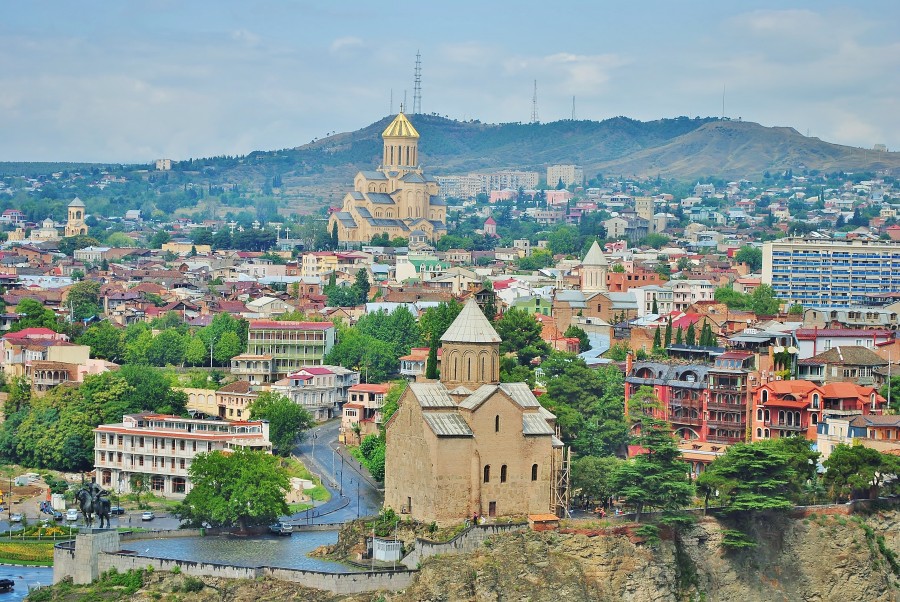
Panorama of Tbilisi. Georgia.
The Abanotubani baths are a nice sight because they look like round brick mushrooms with a fireplace on the top and are nicely incorporated into the old town. Besides all the traditional baths in this region and also in Iran look like this. Of course I also tried and admit that traditional baths have their good and bad sides. There are only men’s baths, only for women and couples baths. Unfortunately I was in the male and was not impressed because it reminded me of a “wet pedal club” where hairy creatures were leaving their dungeons over the pool and in the shower. The price of the ticket also includes a massage, and unfortunately not massaged me beautiful beautiful butterflies with big bumpers but obliśny fat with big belly. He hit me well and struck a rough, wet cloth and then asked if I liked it. Well … as long as I did not have to look at him. Each bath has a hot and cold swimming pool, showers and concrete massage beds and mosaic ceilings. The traditional bathhouse is a good experience with a nice kitten but not with disgusting guys, and I’m afraid to even think how eagerly it must be in the Turkish bath. Besides, the Georgians are usually very nice to the Poles and the baths were also, although I would prefer not to be too nice there. As far as I remember the entrance cost 3 lari and the massage is probably 8 lari. After all, I felt much better although in a sense not quite.
Then I went to see a mosaic mosque and a small canyon cut across the river and then narrow streets between old houses I went up to Narikala Fortress . There is a dominant view over the city of the building whose walls were built in the fourth century when it was a Persian citadel. Then in the 8th century the towers of the tower and most of the walls were built by the Arab emirs. Narikala Fortress is also an important historical symbol of the city, because over the centuries this strategic place was also attacked and battered by the Turks, Georgians, Persians, Arabs and finally the Russians. On the site of the fortress there is a refurbished church of St. Nikolasa and wonderful viewpoint on Tbilisi. Near the fortress, also on the top of the mountain is a 20m memorial Kartlis Deda or monument Georgia Mother who in one hand holds a sword in the second cup of wine, which simulates the openness and defense of the Georgian people. Above, there is a botanical garden opened in 1845 year. The peak can be reached either by foot or by cable car.
On the same side of the river, but downstairs there is Rustaveli Avenue, where the social and political life of the Old Town and the Szusta Rustaveli are centered , where there are several museums, the Kashevi church , the opera and the most important building is the parliament building . In the narrow streets there are many restaurants and small shops, and some of the most historic buildings in Tbilisi, such as the Jvaris Mama church, where the first church stood in this place already in the fifth century and the current construction dates back to the sixteenth century. In this church I recommend above all beautiful frescoes that have been renovated in blue and red. The Armenian church Narosheni from 1793, which unfortunately is not in good condition, On the street Leselidze 47 there is also a synagogue built in 1904 which in the opinion of many people is very hospitable but I just threw away from here. When I stood outside, I saw a monument typical of a Jewry candlestick, and as soon as I walked through the threshold the Jews looked at me and thought of their passing. They told me to put a cap on my head, but when I refused to throw it away and admit that I was not at all sorry. On the one hand I wanted to see their temple but on the other I thought I was too proud of my own Catholic religion to take care of their behavior.

Tbilisi Old Town. Georgia.
Outside, however, I met a beautiful Russian woman who smiled, photographed and after a few moments I forgot what I had just experienced. Another valuable object is the Sioni Cathedral , which was built between the 6th and 7th centuries although it was destroyed so many times that most of the present building dates back to the 13th century. The Cathedral of Sioni I liked the most because it has a beautiful altar, nice paintings and the cross of Saint Nino – Patroness of Georgia. The cathedral of Sioni is built on the plan of the cross according to the old custom. Going further, I also passed the seat of the Georgian Catholicos-Patriarch church and then Anchiskhati Basilica, which is the oldest church in Tbilisi, since it has remained unchanged since the 6th century.
On the left side of the river we have Avlabari district and some very important objects. I think of a very picturesque vertical cliff coming out of the river Kury on which is built among others the church Metekhi and the monument of King Gorgasali . The first church stood in this place already in the fifth century, but due to the tragic history was many times destroyed by the Turks and Persians. There was a palace complex, a theater and a prison, but today the church of Metekhi functions and hosts holy masses. This church is the flagship of Tbilisi and is best seen from the Narikala Fortress and from the Polabysky Metekhi Bridge. On the other side of the bridge is a small, well-kept park and a lighted fountain which always moves in the evening to the rhythm of music. This park is a very peaceful place to meet families, just by the river and with souvenir stands. From the park we can either go on a modern, illuminated bridge to the other side of the river or go up to the Avlabari district.
The Presidential Palace , which is covered with a glass dome, is also well visible from the Metekhi Bridge, and it is illuminated at night. Walking down the small and destroyed streets of Avlabri, I reached the Cathedral of the Holy Trinity (Tsminda Sameba) . This is huge by the great “O” church built in traditional Georgian style which after 10 years of construction was put into use in 2004. It has a huge dome, is high at 84m and has 5 entrances. Each entrance has a huge door and the whole is filled with paintings, marble and beautiful sacred art. Besides Tsminda Sameba lies on a hill and leads to her stairs and the whole area is surrounded by a garden. I also think walking along alvabri streets is a very good contrast between the poor life of the people and the wealth that the temple represents.
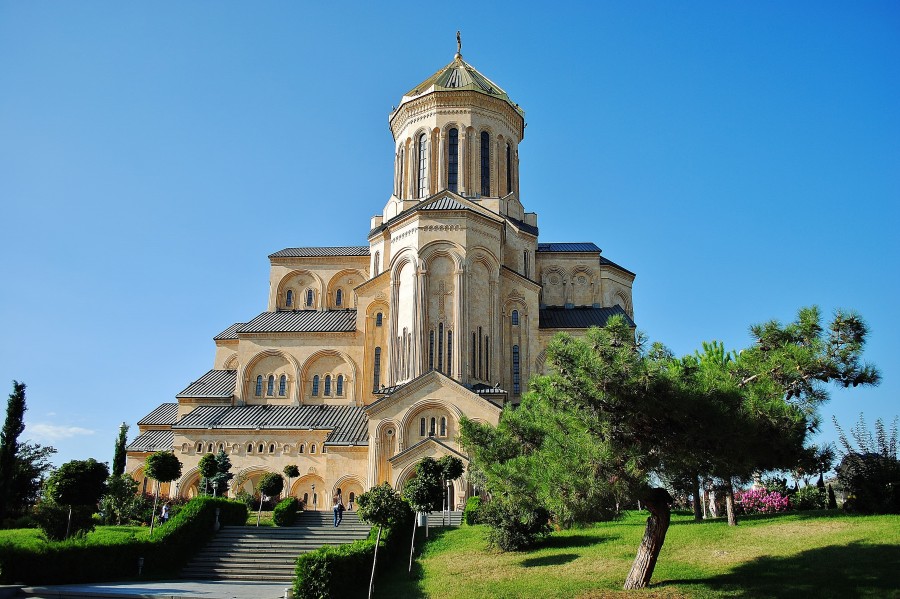
Sameba Cathedral. Tbilisi. Georgia.
Another time I was in the Vake Park in western Tbilisi, which occupies an area of 200 hectares and is a popular resting place. I was just walking and practicing although the people interested can also take a cable car to the summit of the Lake to bathe during the summer heat. I came to Vake Park by accident because Azerbaijani consulate is nearby and from there I went for a walk. There is also a university nearby. For couples with children I recommend primarily the Mtatsminda theme park where there are many attractions for the whole family .
Then again, many times I strolled through the streets of the Old Town, sat at the fountain and watched the beautiful capital of Georgia. In the evening I stopped the bus and for a couple of cheap tetri I went back to my cheapest hostel which however I remember very nice.
Trips outside Tbilisi
Ananuri
About 72km from Tbilisi there is an Ananuri Castle complex built in the 13th century which lies in a picturesque spot on the Aravgi River. In Ananuri territory there are two castles, towers and fortified walls as well as two churches from the 17th century. On one of the walls there is a large bas-relief depicting the cross and a creeping bush of grapes, and in the middle there are remains of frescoes destroyed by a fire in the eighteenth century. The Ananuri Castle and its churches are a beautiful part of the medieval landscape, but it is also beautiful that after a day of sightseeing I was swimming in a peaceful turquoise river. At the entrance to Ananuri there are stands with interesting souvenirs. I also recommend going across the bridge towards Tbilisi because there is just the best place for photos.
To Ananuri I went from the Didube station (3 lari, 45 minutes) and came back hitchhiking with a pretty Russian. I was lucky because the mercedes stopped.
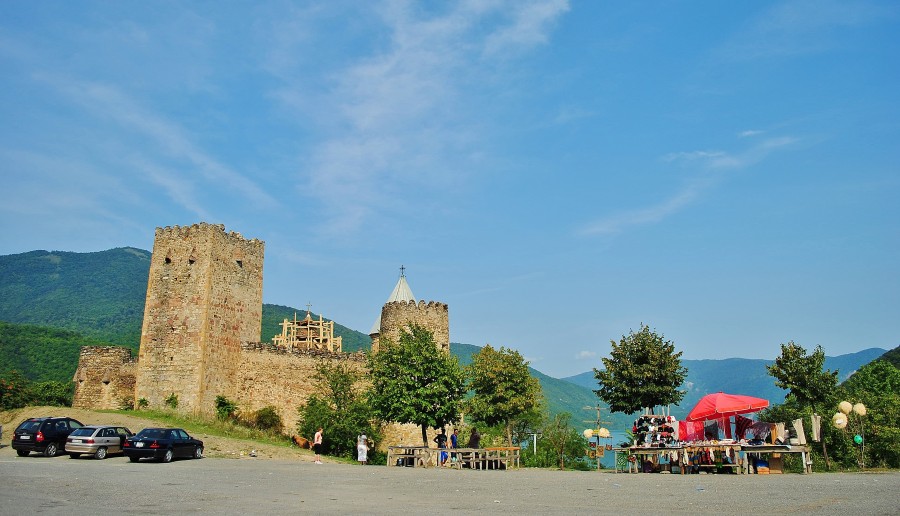
Entrance to the Christian Ananuri Fortress. Georgia.
Gori – the birth place of Stalin
About 80 km from Tbilisi there is a small town called Gori, which is associated with only one man. Here Iosif Jughashvili was born and raised, for some famous and for the most part defamed Joseph Stalin. Gori is a popular tourist destination due to the Stalin’s deceased Museum , which is located in this city on Stalin Street and not far from Stalin Square. In front of the big building in honor of the bearded leader there is a statue of Stalin, the house where Stalin lived as a child, a nice park and a private luxury carriage in which Stalin and his dignitaries crossed the Soviet Union. I will not make a mistake if I say that this small 50,000 city was on the map only because, as the red legend states, it was here that the beginning was “father and teacher of the Soviet people who emerged from the infinite fields of Russia” …… and he murdered, He was under absolute terror and declared war on his people, but the information in the museum simply was not there.
! ! ! A link to the full article on “The Stalin Museum in Gori” is provided below this article ! ! !
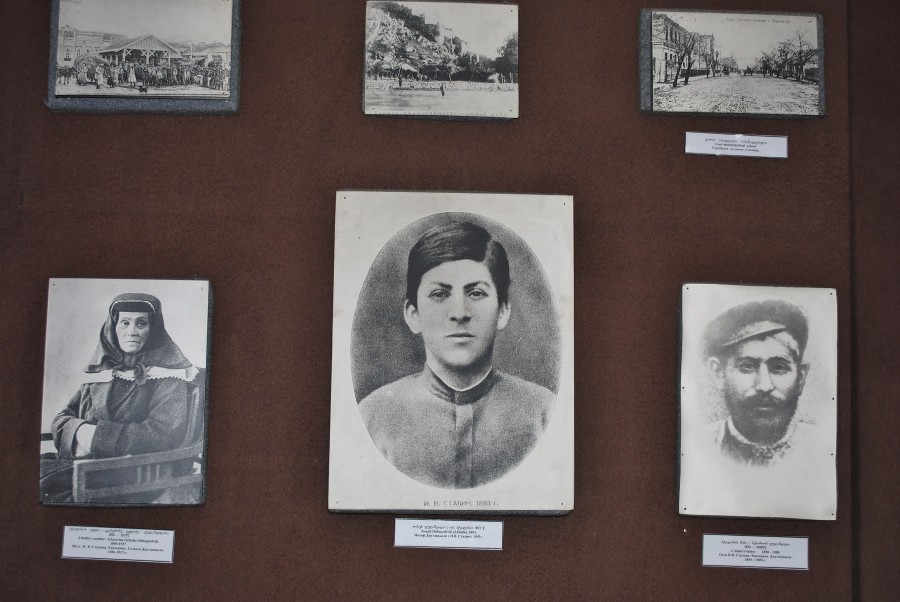
To this day, Georgians love their communist mass-murderer Stalin. Georgians brought up on the lies of communism and desperate for greatness are proud of Stalin, as are the Ukrainians of Bandera. The difference is however, that Georgians at least like Poles.
In addition to the Stalin Museum in Gori, I also recommend a citadel to climb on an uneven stone road. At the top there is not much but it is a nice trip offering nice views.
To Gori I got a bus for 4 lari in 45 minutes from Tbilisi Didube and on the way back I took a hitch from the main route.
Uplistsikhe – the rocky cave town
Uplistsikhe is a rocky town about 10km from Gori and one of the oldest settlements in the Caucasus. Uplistsikhe was discovered around 1000 BC in the Bronze Age but its rocky cliffs were expanded from about the 6th century BC to the 1st century AD Archaeologists discovered this place in 1957 when most of the caves and rock caves were covered by trees and only the summit was visible. In the Middle Ages Uplistsikhe had a strategic position between the forests and deep valleys and in its glory lived about 20,000 people. Uplistsikhe As a bridge between Europe and Asia, it became an important shopping center and was also conquered by the Arabs and Mongols. In the 8th and 9th centuries the Uplistsikhe was a defensive fortress against the Muslim invasions but eventually fell.
With the transition of Georgia to Christianity on the spectacular cliffs of Uplistsikhe, several churches and basilica were built, with pillars in the middle of which some were converted from pagan temples. In the rocks have been carved play caves with pillars and decorated ceilings, a place for priests and residential grottoes. Archaeologists have found many types of jewelry, sculptures and ceramics from the centuries that are now in the museum in Tbilisi. Uplistsikhe is an exceptionally attractive place built on several floors, and from the top it has a nice view of the Mtkvari River. Compared to the previously described rocky town of Vardzia Uplistsikhe is very small because it is only 8 hectares but the way in which this city is built belongs in my opinion to the biggest tourist attractions of Georgia.
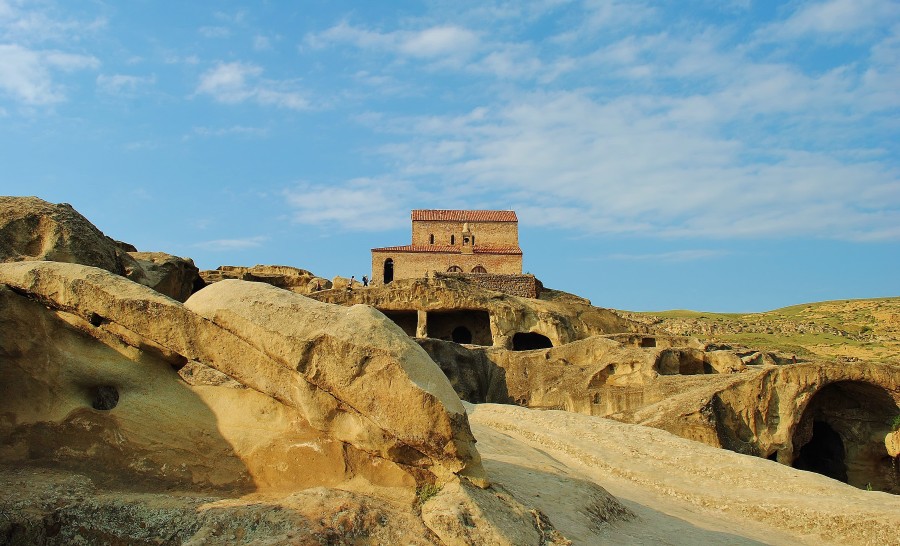
A rock city full of caves and adventure paths. Uplistsikhe is only 10 km from Gori.
Transportation to Uplistsikhe from Gori cost around 15 lari for 3 persons. The driver blew me off on the main route on my way to Tbilisi.
Mtskheta
Mtskheta is an important cultural heritage of Georgia because this small town has one of the oldest and most important churches in the country and was the capital of Georgia from the 3rd century BC to the 5th century AD. Mtskheta is historically and culturally a very important place and even after King Vakhtang Gorgasali moved his capital to Tbilisi in the 5th century, Mtskheta was still the religious capital of Georgia and the seat of the Georgian Orthodox Church. In addition, Mtskheta is situated picturesquely at the junction of the rivers Aravga and Mtkvari, and its traditional development consisting of small houses is covered with vines. Even without a thorough tour of the magnificent churches, the small stone walls of Mtskheta and the old town are enough reasons to come here.
The main object is the cathedral Svetitskhoveli , built in the 11th century, although the defensive wall was built in 1878 and frescoes in the sixteenth and eighteenth centuries. Although Timur attacked Mtskheta in the 14th century and partly destroyed the cathedral, it is still one of the most beautiful today. It has a traditional bell, a beautiful sculpture from the outside and from the inside, frescoes and a pretty altar, while also dominating the low-rise buildings of Mtskheta. According to legends, the cathedral contains a part of the garb of crucified Jesus, who reportedly was a Jewish resident of Mtskheta during his stay in Jerusalem at the time when he broke off Jesus’ clothing and brought them to Mtskheta, and then a Jewish sister named Sidonia took the robe from her brother and died in a flood of faith. Then she was buried with the garment of Jesus and the church was built there. The object itself is quite large and has interesting bows and bas-reliefs.
Another church, just behind the cathedral, after passing along a narrow stone street is a tiny Antioki churchlying in the garden in the monastery near the river. This church dates back to the time of St. George. Nino is about the third century, although frescoes in the middle are new. From the garden where the Antioki church is located you can see the top and at the top of the monastery Jvari. Another church is Samtavrowhich also lies in the monastery area. It was built in the traditional Georgian way and dates back to 1130.Next to it is also a very small chapel Tsminda Nino from the fourth century where according to legend prayed St.. Nino.
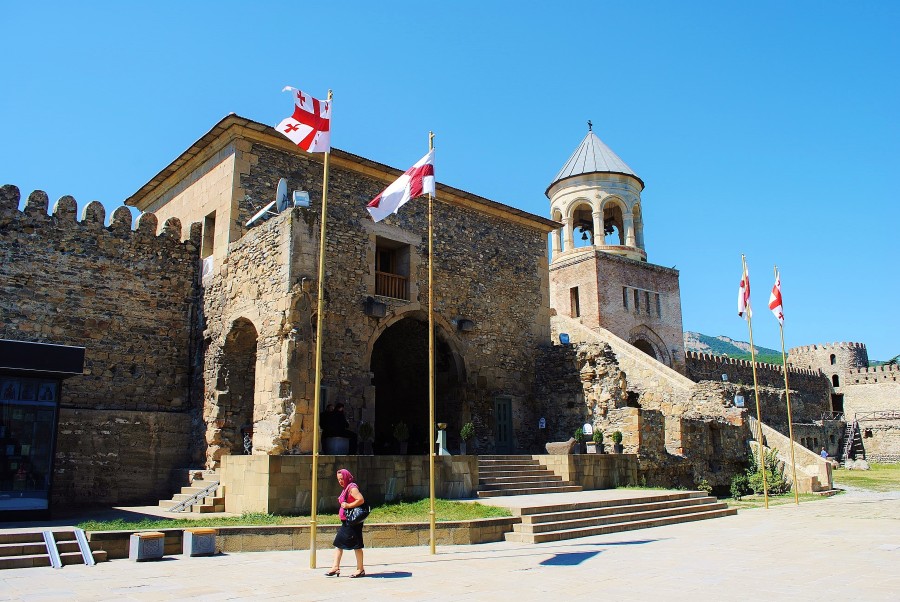
Mtskheta – the former capital of Georgia with several impressive churches. Mtskheta is important to Georgian national identity and is situated among picturesque nature.
On the other side of Mtskhety, about 30 minutes walk (1.2km) from the center is a completely different object. On the hill near the river are the ruins of the castle Bebris Tsikhe. There is a building standing away from other buildings, alone “inviting” travelers to visit it. Bebris Tsikhe was a very pleasant, quiet trip. There are sharp bushes and hidden lizards.
Mtskheta is located only 25km from Tbilisi and the bus from Didube station depart very often. The journey takes 20 minutes and costs only 1 lari.
Jvari Church
Jvari church is one of the holiest churches in Georgia and also one of the oldest. It was built in the 6th century and stands on a hill which is well visible from afar. Jvari means “Church of the Holy Cross” in the translation. Nino set up a cross of miraculous miracle at the top of a pagan temple, which brought people from all over the Caucasus. Jvari’s own design represents the classical sacred style of early Georgian Christianity. The Jvari is built on a cross plan, features symmetrically arranged rooms and piling up roofs and a low main bell. In the midst of dusk, by the stone walls, numerous candles and images of saints give the specific, mysterious and profound nature of the monastery. From above there is an impressive view of Mtskheta and a combination of two rivers – Aravgi and Mtkvari.
When it comes to getting to Jvari, the easiest way is to take a taxi back from Mtskheta for 15 – 20 lari with a half hour wait. The road is long and winding because the distance from Mtskheta is 15km, although from the bottom it looks like a close up uphill. Unfortunately, it is not and I’m sure many have already realized their mistake while climbing. Of course you can climb what takes about an hour but in the sun of the Caucasus is a challenge.

Jvari Church. Georgia.
Davit Gareja
My trip to Davit Gareja was very interesting. From Tbilisi you can take a tour of the tourist company for big money, but it is easiest to take the bus from Didube to the village of Gardabani , which cost me 2.5 lari and took about 1.5h. Here I had to bargain with local taxi drivers who were aware of my bad situation. Davit Gareja has no public transport and the road leads through a Soviet military training ground. So I went away from the village and came up to me Azer who suggested that he take me there and back for 40 lari. Well, I was alone and I really wanted to go there. Coming through the weedy ground, we overcame the hills and pits in the road. It was very nice, even more so, that sometimes we also passed military trucks giving this place more interesting character.
Due to their seclusion for most of the twentieth century these areas were used for military bases and polygons. In the times of the Soviet Union this object was very neglected, but today the priests live there, the restoration of restaurant work and the isolation and abounding semi-desert views the object is very popular tourist. In addition to the churches, there are also hundreds of chapels, rooms, purpose and dining rooms cut into the rocks. Unfortunately, some of the facilities on Davit Gareja are in Azerbaijan, which has caused a conflict between the two countries.
The two largest and most popular churches are Lavra and Udabno although in my opinion this is only the beginning. Both churches were created at different times and their various parts come from different years.For example, Lavra is built on three floors, has a nice courtyard and observation tower, and narrow passages under stone pillars. The Lavra complex also houses three churches and caves and graves, including Davita and his companions.
Udabno is further away, after defeating the mountain before entering Lavra. There is a small rocky town consisting of rooms and chapels carved in the walls, still with frescoes dating back to the Xth and XIII centuries.
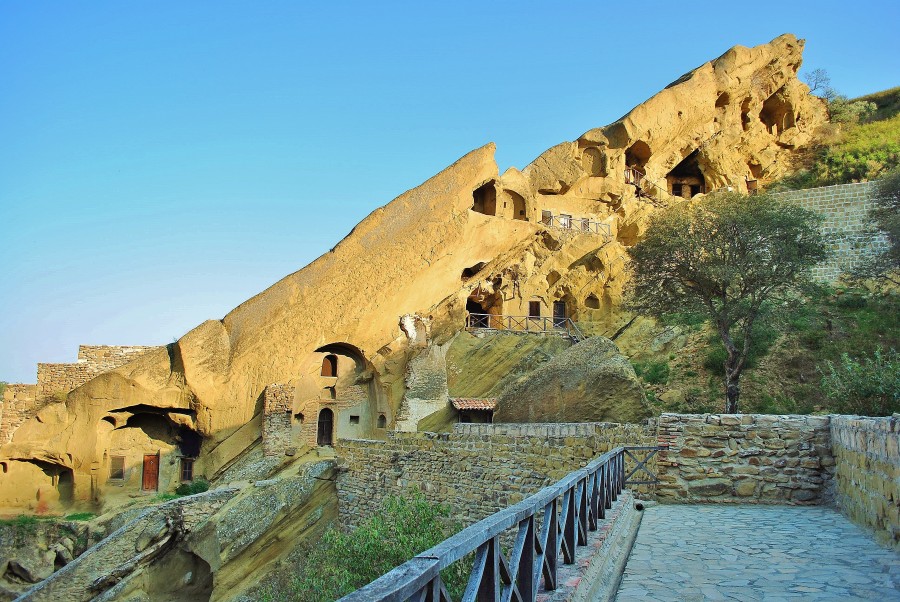
The rock town of Davit Gareja caves. Georgia.
It is important to remember that Davit Gareja is not only churches and caves, but also beautiful pleneries that tourists should enjoy. The loneliness of this place at the crossroads of Georgia and Azerbaijan amidst uneven, semi-deserted views at least for me was also a huge attraction.
On the way back my driver drove me across the wilderness to the village of Gardabani and from there I hitched a hitch in the town of Rustavi. I got on the bus to the Didube station in Tbilisi for only 1.30 lari.
Transport from Tbilisi to Kazbegi
I paid 10 lari and the trip leading through the green valleys and mountain views lasted 3h. At the station of Didube I met my travel companion Kamil, who was just getting on the same bus and hoping that I would not meet him. What a coincidence.
Kazbegi lies 157km north of Tbilisi.
Kazbegi
Kazbegi is a small village a few kilometers south of the border with Russia and located on the Georgian military highway, which is very popular with tourists due to the snow-capped peaks on which stands the well-known Tsminda Sameba church. Today, the official name of the village is Stepantsminda, but despite this, travelers are known as Kazbegi. As soon as we arrived we came to the woman who offered us accommodation for only 15 lari per person. Kazbegi is such a popular place that there are several bars and shops, and the locals open their doors for travelers as it is an additional source of income. The village is situated at an altitude of 1740m and offers many opportunities for lovely walks, of which the most popular is the uphill walk to Tsminda Sameba Church.
But before I went upstairs I spent some time on the river Tergi and in the local park on the dried fountain and then also on the main square of the town called Stalinis Moedani. I also add that the buildings in Kazbegi do not stun art or form because they are just post-Soviet solids. At this point I came across the old, fatty women eating bread that wished not want to be my best models that day. From that photo they always made me laugh. After a nice dinner in a local pub where shish kebabs and hinkali were the base of the menu I went with my companion to travel home on the way passing a few interesting wrecks of cars.

Church of Tsminda Sameba. Georgia.
The next day we went up the hill to the 14th century church of Tsminda Sameba, which today is a symbol of Georgia because it is on many postcards and everyone knows it. The uphill climb took us 1.5hi I admit that as for the mountain trail it was a large piston because it was the whole village.
All the tourists went, went to the church to pray and the old women from my pictures went. The trail was easy and pleasant, and at the height of the church there was a plateau where the Georgians had camped and served me food and young boys offering horseback riding. The church was so crowded that it was hard to get in and the greasy women sat at the entrance as they were gathering small things. The interior was a standard Georgian church and I think as an object it is very overrated though still worth getting to know, especially if the tourist made the effort to get there. Below the church is also an impressive stone cross.
Climbers who have equipment and fancy longer trips can continue to Mt. Kazbek 5034 m above sea level
Transportation from Kazbegi to Tbilisi
10 lari, 3h to Didube station.
Transportation from Tbilisi to Sinhnaghi
I had to take a subway from Didube to Sambori Station as they departed for Kachetia. The distance of about 113km was beaten in 3h for only 6 lari.
Sinhnaghi
I came to Sinhnaghi after dark, but so quickly arranged a bed in a hostel covered with grapes. Walking down the rocky street and having nice houses on either side I got to the hostel where I only paid 10 lari for a night plus 5 for a delicious breakfast. I felt very well here as I sat on the terrace, ate the grapes and enjoyed the peace.
Sinhnaghi is a very nice small town with historic buildings, which is the main tourist base of Kachetia and which, apart from several objects also has a nice atmosphere, scenic views and ubiquitous vineyards. Two thirds of the buildings in Sinhnaghi come from the 17th, 18th and 19th centuries, which today are thanks to the restaurant’s excellent work, and besides, the city is also surrounded by 4 km of defensive walls and has a couple of pretty churches. As for the vine, I advise to come here in October when the whole wine festival is held for one whole weekend. The Georgian government is investing heavily in one of the most charming Georgian cities, while retaining the traditional style, while building, I think very nice small sculptures on the streets, such as the man with a suitcase and an umbrella. In the main courtyard there is also a nice fountain with a high pitched jug and a deer on the top and near the statue of a lady with a child and a dog also under an umbrella. The city is rich in many colors and some houses also have balconies.
I also spent some of my time strolling along the impressive 18th-century defensive walls from time to time standing at wide towers, and also in my churches: Stepan Tsminda and Tsminda Giorgi from the nineteenth century. During my walk I went much further down the town to the old cemetery which seemed forgotten. Sinhnaghi also offers the opportunity to eat national dishes such as hinkali dumplings, fine kebabs and very fattening and even notorious Hujapuri cakes in Georgia. In addition to the church on the lined stone road, among the pleasant historic homes overgrown with vines, local housewives sell products from goat and sheep’s wool.These are usually slippers, caps, bags, socks, and even woolen flowers in the vase and I assure that their abilities are extraordinary.
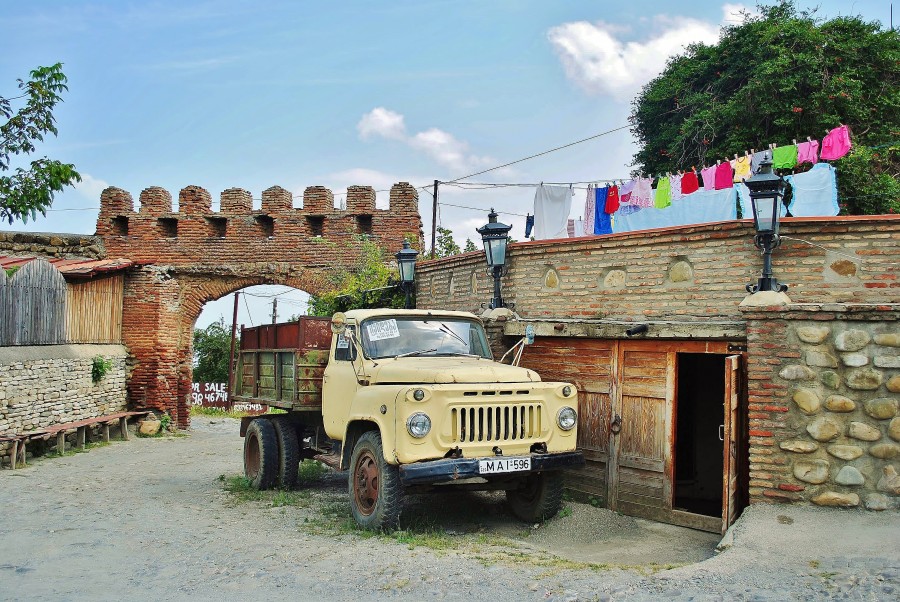
Sighnaghi was a lovely Georgian town. As if I went back in time, but in a good way.
Being in Sinhnaghi I was invited home to one lonely Lord which was a good experience. He lived alone in a neglected home because he said since his wife died of cancer he did not even want to clean up. We were sitting on a large balcony watching the view and eating the watermelon and roasting the grapes from the roof.
I also met a young Georgina with a big breasts who guided me once more in her city and said she was going to leave this boring village because she spent her whole life here. I was not surprised because as a tourist attraction Sinhnaghi is very good for a day or a maximum of two if you count in a stay trip to Davit Gareja, but spend your entire life here ..
I would most recommend this beautiful little town.
Transportation from Sinhnaghi to the border with Azerbaijan
First from Sinhnaghi I went to Tsari (20min, 1 lari). Tsari is not interesting. Although there is life there is only a transport hole on the way to the border.
With Tsari I stopped the rusty, barely breathless marshmallow which brought me through the lands of bad views to Lagodekhi (35km, 3 lari, about 0.5h). Lagodekhi is the last town in front of the border which has a fatal bus station, empty restaurants, bored people and many unemployed taxi drivers.
From Lagodekhi I hitchhiked to the border crossing about 5km, what was very fast. I will add that border crossing is the last place where you can buy Azerbaijani currency and make cheaper shopping. I had breakfast here at frontier hosts. The Georgian border ran smoothly and soon after I was in Azerbaijan .
Summary of Georgia
Georgia is a very attractive tourist destination where the old Christian culture meets beautiful mountain views and the people are helpful to tourists. Although Georgia is a small country there is a lot to see here and therefore the time spent traveling through this country can last from a minimum of 3 weeks to a few months for more ambitious mountain lovers. It is hard for me to enumerate my favorite places because antique churches against the mountains and sometimes also turquoise lakes like Ananuri are not in the forefront of attraction and despite being one of the most spectacular.
I think recommendable is the old town of Tbilisi, cheese pastries in Kutaisi, Rabati fortress in Uplistsikhe, Mtskheta, rocky towns like Vardzia or Uplistsikhe and certainly unforgettable contact with people. You also need to spend some time on mountain tours with glaciers or ancient churches and rest on the Black Sea near Batumi. Georgia offers a lot. This is a beautiful country.
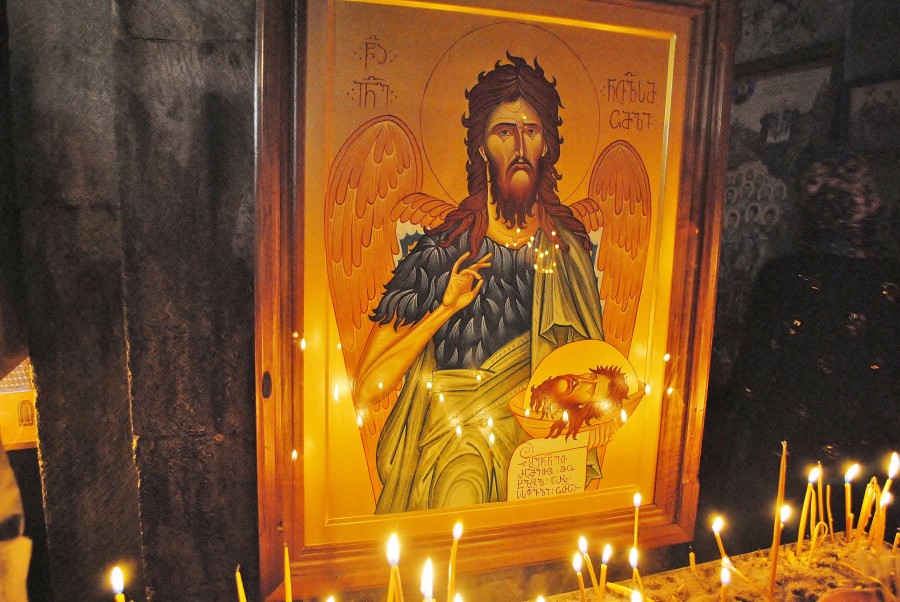
Orthodox church icon. Georgia.
Marneuli (on the way from Azerbaijan to Armenia)
I have been to Georgia several times due to the closed border between Armenia and Azerbaijan and therefore the road to any of these countries led only through Georgia. Returning from Armenia, I stopped in Tbilisi for a while and from there I took a marshrutka to Sadakhlo, which is the border crossing with Armenia, although it is important that Marneuli is located at the crossroads from where you can go either to Armenia or Azerbaijan.
Before I got to Armenia, however, I had to transfer here and I would like to share my impressions of this depressing place. Marneuli has a dirty but well-stocked bazaar, a huge amount of cars due to trade between the three countries of the Caucasus, dead animals flayed on hooks and lots of money changers. So I would describe this city as about 20,000 dirty business hole. At least I ate breakfast here for a few lari and had an interesting conversation with my boss about life in Georgia and Poland. As I expected, life here does not spoil anyone.
Transport to the border with Armenia cost 3 lari and I was lucky to be on board another “ancient” bus.
A must read:
- Akhaltsikhe
- Ananuri
- Batumi
- Chalati glacier
- Christianity in Georgia
- fortified churches in Georgia
- Gonio fortress
- hachapuri
- Holy Trinity Cathedral Tsminda Sameba
- Kazbegi Tsminda Sameba
- Khertvisi fortress
- Kobuleti
- Kuruldi lakes
- Mestia
- Metekhi church
- Mtskheta
- rock town Davit Gareja
- Sinhnaghi
- Stalin's museum Gori
- Tbilisi
- Tbilisi King Gorgasali monument
- Uplistsikhe
- Vardzia



































